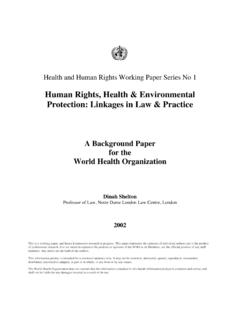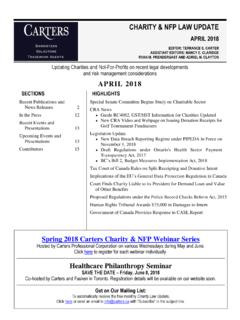Transcription of POSITION PAPER - United Nations Office on Drugs and Crime
1 UNODC AND THE PROMOTION AND protection OF human RIGHTS POSITION PAPER 2012 This PAPER is not an official document of the United Nations and has not been formally edited. The designations employed and the presentation of material in this publication do not imply the expression of any opinion on the part of UNODC concerning the legal status of any country, territory or city or its authorities, or concerning the delimitation of its frontiers or boundaries. 2| The Charter of the United Nations includes an obligation to promote universal respect and observance for human rights. Resolution 51/12 of the Commission on Narcotic Drugs reaffirmed the importance of countering the world drug problem in a multilateral setting with full respect for all human rights and fundamental freedoms, and requested the United Nations Office on Drugs and Crime to work closely with the United Nations human rights agencies in this endeavour. In his subsequent Note to the governing bodies of UNODC in 2010 entitled drug control, Crime prevention and criminal justice: A human rights perspective, the Executive Director indicated a way forward to further mainstreaming of human rights in the work of the Office .
2 In July 2011, the Secretary-General endorsed a human Rights Due Diligence Policy for UN support to non-UN security forces (HRDDP) , which seeks to implement obligations under international humanitarian, human rights law and refugee law. Building on this foundation, this PAPER is intended to articulate UNODC s perspective on promotion and protection of human rights as part of the work of the Office . The PAPER will therefore: Describe human rights and their relevance to the work of UNODC Set out the responsibilities of UNODC with respect to human rights Provide guidance on how human rights will be further integrated into the work of UNODC In line with this purpose, the POSITION PAPER is divided into three main sections: A background section introducing international human rights law and the relevance of human rights to the work of UNODC A conceptual section examining the human rights responsibilities of UNODC as a part of the wider United Nations system A practical section outlining how the Office is integrating human rights into its work BACKGROUND human rights in the UN system human rights are at the core of all work of the UN system and together with peace and security and development represent one of the three, interlinked and mutually reinforcing, pillars of the United Nations enshrined in the Charter.
3 UNODC is in the unique POSITION of working across all three pillars in its efforts against Crime , Drugs and terrorism and in supporting Member States to deliver a safe society founded on the rule of law. A key component of UNODC s work on the rule of law is its specific mandate to guard and protect the United Nations standards and norms in Crime prevention and criminal justice. These standards are further explained in the box on page 4. Bearing in mind the centrality of human rights to the aims of the United Nations organisation and to the work of UNODC, the Office aims to maximise the positive human rights impact of its work, and always take the human rights perspective into account while planning our programmes. What are human rights? human rights constitute a set of rights and duties necessary for the protection of human dignity, inherent to all human beings, irrespective of nationality, place of residence, sex, national or ethnic origin, colour, religion, language, or any other status.
4 Everyone is equally entitled to human rights without discrimination. As such, human rights are universal, interrelated, interdependent and indivisible and constitute the basis of the concepts of peace, security and development. 3| Customary international and treaty Law Universal human rights are often expressed and guaranteed by law in the form of treaties, customary international law, general principles and other sources of international law. human rights law lays down rights (and sometimes duties) for individuals, and corresponding obligations - both positive and negative (that is, things to do and things not to do) for governments in order to promote and protect the human rights and fundamental freedoms of individuals or groups. The range of human rights contained in international law cover almost every aspect of individual and community life, from civil and political rights, to economic, social, cultural and developmental rights.
5 Some of these rights may be limited by states on grounds such as public safety, order, health, morals and the rights and freedoms of others, whilst other rights may not be limited under any circumstances. From a legal perspective, human rights contained in customary international law are binding on all states. The scope and content of the customary international law of human rights is (as all of customary international law) an evolving concept. A number of the provisions of the Universal Declaration of human Rights of 1948 (UDHR) are recognized as having achieved the status of customary international law. The prohibition on torture, genocide and slavery, as well as the principle of non-discrimination, for example, may safely be considered to constitute customary international law. The UDHR and the United Nations Charter were among the first documents at international level to formalize historical concepts of rights that are inherent to many legal systems.
6 The UDHR was also the predecessor to international human rights treaties such as the International Covenant on Civil and Political Rights and the International Covenant on Economic, Social and Cultural Rights. Together, these three documents make up the International Bill of Rights . Unlike customary international law, human rights obligations contained in treaties are binding only upon ratification or accession. Ratification is the process by which a state expresses its consent to be bound by a treaty it has already signed. Accession is the method by which a state becomes a party to a treaty it has not signed. For international human rights conventions or treaties, signature alone is insufficient to create binding obligations, though the Vienna Convention on the Law of Treaties requires a signatory not to take action that would defeat the object or purpose of the signed treaty.
7 human rights treaties exist at the global and regional level. Where a state has ratified both an international and a regional treaty, such as the American Convention on human Rights, it is bound by both sets of obligations at the same time. Aside from those rights assumed under customary international law, the particular human rights legal obligations of an individual state therefore depend upon the relevant treaties it has ratified. International human rights conventions or treaties apply only when a convention or treaty is in force (usually following the attainment of a particular number of States parties) and only to those countries that have ratified or acceded to the particular convention or treaty. There are two important ways in which obligations may be modified or suspended. A State party may make specific reservations on ratification, or when a public emergency that threatens the life of the nation arises, may derogate from a number of rights.
8 Certain rights, however, such as the right to life, are non-derogable, and they apply in all situations. American Convention on human Rights (ACHR) African Charter on human and People s Rights (ACHRP) European Convention on human Rights and Fundamental Freedoms (ECHR) Regional and Global Core human Rights Treaties International Covenant on Civil and Political Rights (ICCPR) International Covenant on Economic, Social and Cultural Rights (ICESCR) International Convention on the Elimination of All Forms of Racial Discrimination (CERD) Convention on the Elimination of All Forms of Discrimination against Women (CEDAW) Convention against Torture and Other Cruel, Inhuman or Degrading Treatment (CAT) Convention on the Rights of the Child (CRC) International Convention on the protection of the Rights of All Migrant Workers (ICRMW) Convention on the Rights of Persons with Disabilities (CRPD) International Convention for the protection of All Persons from Enforced Disappearance (ICPED)
9 human rights and Security Council Resolutions human rights matters may be dealt with by the Security Council in the context of resolutions on general issues (such as Security Council resolution 1325 on women, peace and security) or with reference to situations in specific countries (such as resolution 1556 prohibiting supply of weapons to non-governmental entities and individuals in Darfur, Sudan). Security Council resolutions have a legally binding force when they are adopted under Chapter VII of the United Nations Charter in response to a threat to peace, breach of peace or act of aggression. The practice of the Security Council shows that severe human rights violations in one country may pose such a threat to the peace and merit action by the Council. In such cases, the factual and legal findings of the Security Council are also binding for UN agencies. Some resolutions may specifically call upon UN agencies to take certain action or to refrain from taking action in regards to a particular country.
10 4| Other human rights sources human rights standards can also be found in the form of declarations, principles, standards and recommendations, including those issued by United Nations bodies such as the General Assembly and the human Rights Council. Such instruments have, in general, no binding legal effect but have an undeniable moral force and provide practical guidance to states. They do, however, have the advantage of applying equally to all United Nations Member States. human rights monitoring In addition to such instruments, interpretation of the content of core treaty-based rights can be found in the work of the monitoring bodies responsible for overseeing treaty implementation. These may be in the form of courts, such as the European or Inter-American Court of human Rights, or committees of independent experts, such as the United Nations human Rights Committee and the United Nations Committee on the Rights of the Child.














